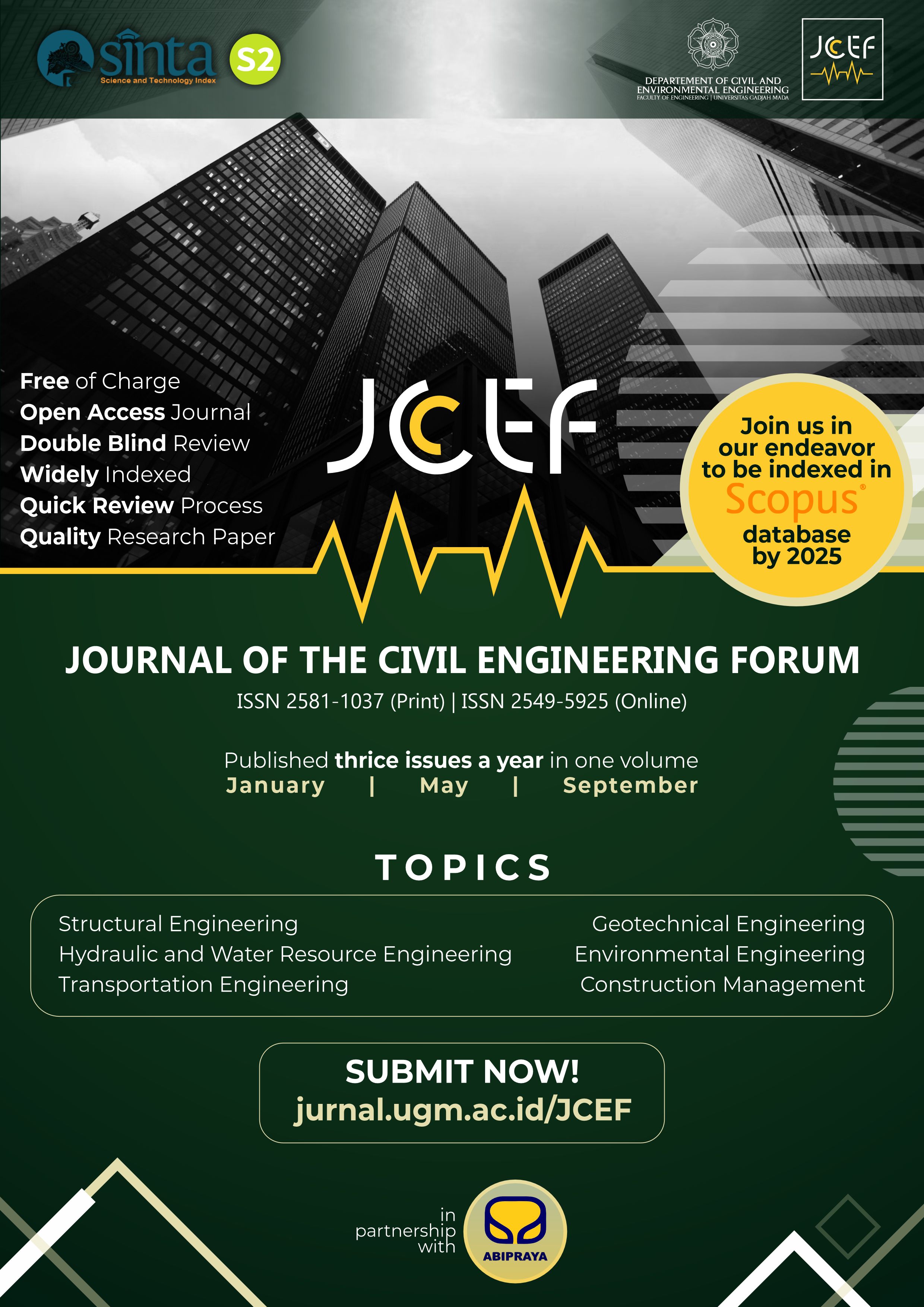Organic Removal Treatment Using Microbubble Generator (MBG) in Eutrophic Disorder Condition
Abstract
The Techno Park basin, built as an extension of a small tributary of the Code River primarily acts as a retention basin for runoff during the rainy season. It improves the quality of water that has been degraded by domestic wastewater discharge from the surrounding community. Therefore, this study aims to assess the extent to which water quality of the basin can be improved with aeration technology. The aeration technology is a Microbubble Generator (MBG) built using a 100 Watts submersible pump with three horizontal nozzles at a depth of 40 cm from the water surface. Furthermore, the profiles of dissolved oxygen (DO) concentration were measured at the basin’s inlet and outlet, as well as the depths of 1 m below surface water and the bottom of the basin. Diurnal DO was measured to investigate the causes of supersaturation. The aeration performance was also determined from the COD parameters at the inlet and outlet. Discharge measurements were then conducted on the tributary/drainage channel to the inlet basin. The result showed that the DO supersaturation concentration has been attributed to the contribution of photosynthesis from phytoplankton such as algae. Furthermore, no change in DO concentration was observed in a range of 1 m depth from the surface of the water to the bottom (0.3 - 0.14 mg-DO/l). In this eutrophic state, DO increased exponentially during the daytime hours and then decreased during the night. The daily measurement showed an increase in the average DO of 2.31 mg/l (standard deviation of 1.56 mg/l), with average CODinlet fluctuations of 18.79 mg/l (standard deviation of 13.56 mg/l) and average CODoutlet of 14.38 mg/l (standard deviation 2.94 mg/l). Due to additional DO concentration coming from eutrophication during daylight, it was not possible to make a precise assessment of the effectiveness of the MBG aerator.
References
APHA, 2005. Standard Method for the Examination of Water and Wastewater, 21st Edition. s.l.:American Public Health Association (APHA).
Boyd, C., 2018. Dissolved oxygen dynamics, s.l.: Global Aquaculture Advocate.
BSN, 2004. Water and Wastewater - Part 22: How to Test the Permanganate Value by Titrimetry. SNI 06-6989.22-2004. s.l.:Indonesia National Standard Agency (BSN).
BSN, 2015. Procedures for Measurement of River Flow Discharge and Open Channels Using Flow and Buoy Measuring Devices. SNI 8066: 2015. s.l.:Indonesia National Standardization Agency (BSN).
Correa-Gonzales, J., Chavez-Parga, M., Cortes, J. & Perez-Munguia, R., 2014. Photosynthesis, Respiration and Reaeration in a Stream with Complex Dissolved Oxygen Pattern and Temperature Dependence. Ecological Modelling, Volume 273, pp. 220-227.
Deendarlianto, et al., 2015. The Implementation of a Developed Microbubble Generator on The Aerobic Wastewater Treatment. International Journal of Technology, Volume 6, pp. 924-930.
Dionisi, D., 2017. Biological Wastewater Treatment Process. Mass and Heat Balances. s.l.:CRC Press, Taylor and Francis Group.
Handayani, E., 2016. Liquid Waste Management with Microalgae Pond Systems: Effect of COD concentration on the Oxygen Supply Adequacy. Yogyakarta: Gadjah Mada University.
Lin, S., 2007. Water and Wastewater Calculations Manual 2 nd- Edition. s.l.: McGraw-Hill.
Pradana, M., Fitriyadi, N., Hans, A., & Dridya, M.A., 2016. Testing the Capability and the Energy Consumption of Micro-Bubble Generators in the Leachate of Wastewater Treatment Process at TPST Piyungan, Bantul, Yogyakarta. Yogyakarta, Department of Mechanical and Industrial Engineering, Engineering Faculty, UGM, pp. 166-171.
Sawyer, C., McCarty, P. & Parkin, G., 2003. Chemistry for Environmental Engineering and Science 5 th Edition. s.l.:McGraw-Hill.
Winkler, M., 1981. Biological Treatment of Waste-Water. s.l.: Ellis Horwood.
Copyright (c) 2021 The Author(s)

This work is licensed under a Creative Commons Attribution-ShareAlike 4.0 International License.
Copyright is granted to authors for the purpose of providing protection for articles written to describe experiments and their results. JCEF will protect and defend the work and reputation of the author and are also willing to address any allegations of violation, plagiarism, fraud, etc. against articles written and published by JCEF. JCEF is published under the terms of the Creative Commons Attribution-ShareAlike 4.0 International License (CC BY-SA 4.0). The author holds the copyright and assigns the journal rights to the first publication (online and print) of the work simultaneously.




